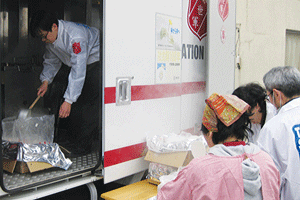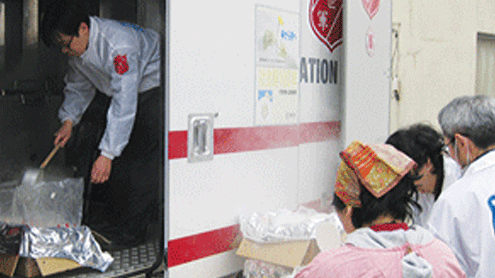Western Territory Emergency Disaster Services respond to the Japan earthquake and resulting tsunami.

By Ken Cavallero
The 9.0 magnitude earthquake that rocked an area of Japan 243 miles north of Tokyo is estimated to be 700 times stronger than the Haiti quake a year ago and 30 times stronger than the 1906 San Francisco quake. It was the fourth largest in the world since 1900, just behind Sumatra’s 9.1 magnitude temblor in 2004.
Less than two hours after it struck Japan, Western Territorial Headquarters issued an alert to the divisional Emergency Disaster Services (EDS) directors advising of the quake and the tsunami watch, which was soon upgraded to a warning for the Pacific Islands including Hawaii, Guam, and the Marshall Islands. The West coast from Mexico to Alaska remained under a tsunami watch.
By 1 a.m.—30 mins. after the alert— Hawaii was preparing. Major George Rodriguera, EDS director for Hawaii Island, reported that all Hawaii corps located in the tsunami evacuation zone were seeking higher ground. Hanapepe, Lahaina, Kahului, Hilo, and all neighboring island officers were on standby.
In Saipan, Captain Tomas Taylor, corps officer and Micronesian Island coordinator, advised that most of the corps families had evacuated to the Capitol Hill Corps Community Center.
When the tsunami headed for Hawaii, the Pacific coast from Point Conception, Calif., north to Alaska were upgraded from a watch to a warning. The tsunami crossed the Pacific in about 18 hours.
EDS responses
•Hawaii—Most damage was to docks and boats with some local area flooding. EDS teams remained ready.
•Cascade Division—According to EDS Director Raunie Aasland, the most damage was in the Brookings and Depot harbors. After examination,emergency shelter and food went to Brookings for displaced individuals living on boats. Most damage was to the commercial fishing fleet, port, and processing plants. Several boats sunk.
– The Tillamook area received some lowland flooding, but no homes were flooded. Army units were on standby.
– The Salvation Army was the only responding relief agency to the Oregon coast.
•Del Oro Division—EDS Director Major Jeanne Stromberg reported that Crescent City’s port suffered severe damage to its fishing fleet and docks. The Army’s Eureka Mobile Kitchen was on standby.
•Golden State Division—Major Kelley Pontsler, divisional business secretary, reported that the Santa Cruz harbor area was hardest hit. The Santa Cruz Mobile Kitchen served evacuees, the Emergency Operations Center, and the response crews at the harbor area. The Watsonville Corps assisted.
•Southern California Division—EDS Director June Loo maintained contact with county and local emergency operations centers.
•Sierra del Mar Division—EDS Director Don Read stayed in touch with county and local emergency operations centers.
The Salvation Army Emergency Response teams from the Hawaii and Pacific Islands to the coastal divisions were ready to respond with little advance warning.













